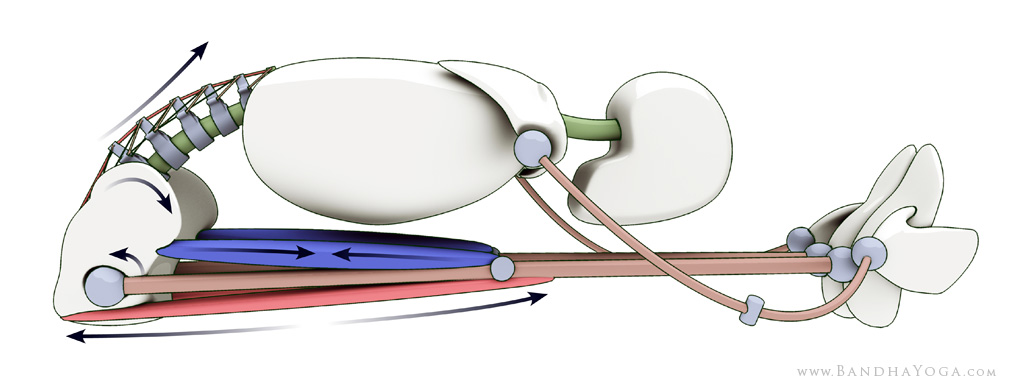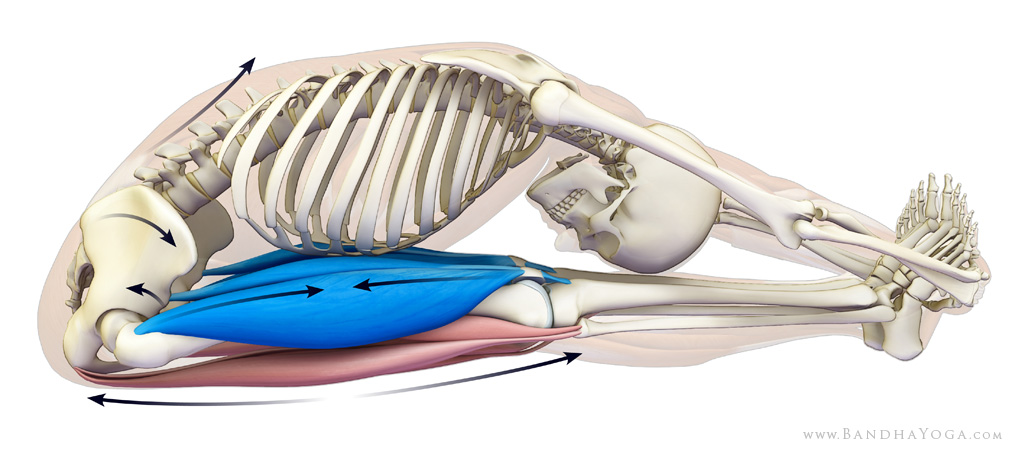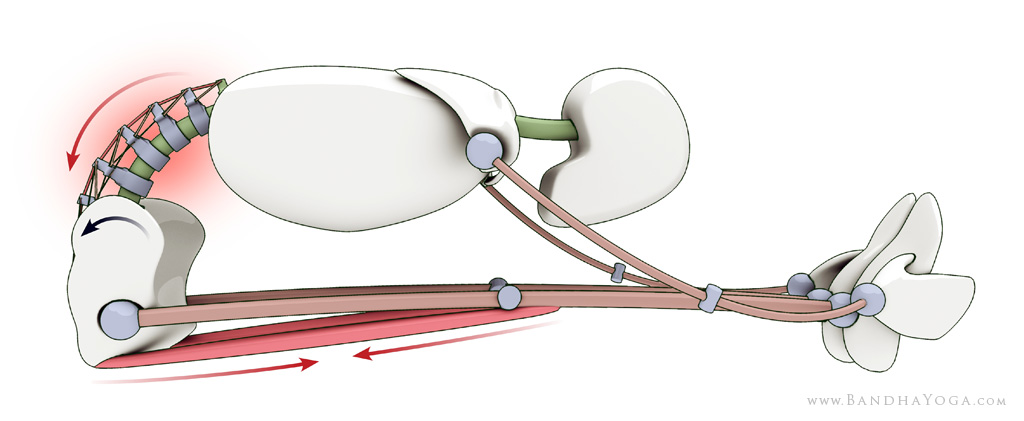今回のブログは、ヨガによる怪我で救急外来を訪れる主な理由のひとつである腰痛についてのお話です。ハタヨガの効果を高めながら、怪我の危険性を減らすにはどうしたらよいのか考察しましょう。この腰痛防止策のシリーズは、「関節リズム」の概要と、それをヨガによる腰痛の防止につなげるヒントから始めていきたいと思います。
また関連情報として、メンズヘルス誌に掲載されたダナ・サントスのインタビュー記事「ヨガは本当にあなたの体を破壊するか?」を読むことをお勧めします。ダナは経験豊富なヨガの実践者であり、プロスポーツ界のトップアスリートにヨガを教える指導者でもあります。彼女はヨガをスポーツトレーニングに取り入れていて、それに関する豊富な情報を持っています。また、最近掲載されたニューヨークタイムズ紙の記事に対するジェイソン・エイミスの反論を読んでおくのも良いでしょう。明確で掘り下げられたデータ分析がされています。
ジェイソンは2010年にヨガによる故障で救急外来を訪れた患者のデータ「NEISS報告書」を私に提供してくれました。私もこのテーマについて前もって下調べの分析をしていました。まずこれらのデータについて説明しましょう。このようなデータは非常に価値のあるものです。なぜならば、起こりうるリスクを明確にし、それをどう回避するか対策を立てることが出来るからです。これは、ヨガで言われるサンスクリット語の「アートマ・ヴィチャーラ」、すなわち真我の探求のひとつといえるでしょう。分析を通して私が感じたことは、まずヨガは他のアクティビティと比べて比較的安全なものだということです。そして次に、緊急治療室に運ばれるような怪我のほとんどは防止可能だということです。怪我には、例えばつま先をぶつける(ヨガに関連した救急外来として報告されていました)など予測不可能な怪我と、身体についての一般的な常識と知識があれば防ぐことのできる怪我があります。今回のようなデータを分析することで、防げる怪我を明確にして、その原因となりうる誤った練習法を排除することができます。
2010年にヨガで怪我をして救急外来を訪れた患者の中で、最も多かったのが腰痛です(NEISS)。実は職場で起こる怪我で最も多いのも腰痛で、これに対する防止策もよく研究されています。にもかかわらず、予防方法を忘れたり出来なかったりして、いまだに多くの人が職場で腰を痛めています。
ヨガのポーズを無理やり、あるいは急いで行う必要は全くありません。正しいテクニックを使い、簡単なバリエーションを用いるなどしてゆっくりとポーズを行えば、ほとんどの場合腰痛は防止できます。そして、このデモンストレーションのように練習すれば、怪我をすることなく、腰痛に対して治療的な効果が期待できます。
私は、腰痛の原因のひとつは、前屈のポーズの際に発生するのではないかと考えています。まず前屈のポーズのパスチモッターナサナにおける腰椎骨盤リズムと骨盤大腿リズムの概要をみてみましょう。
余談ですが、筋膜を伸ばすためにリラックスした前屈のポーズを長いホールドで行う時、私は一定の間隔で優しく大腿四頭筋を収縮させます。主動筋を収縮させる”陽”の働きが、拮抗筋を伸ばす”陰”の働きを抑えることはありません。実際このやり方は、生体力学的にも生理学的にも効果があります。主動筋を収縮させることによって、アライメントを整え、集中力を回復することが出来ます。著書「マット・コンパニオン・シリーズ」では、ヨガのポーズで使われるさまざまな筋肉を理解できるように、このような視点からもアプローチしています。
もし、大腿直筋が「うっ血」を起こすかもしれないという恐れから大腿四頭筋を収縮しないと何が起こるでしょうか?ハムストリングスの相反抑制の働きが失われ、筋紡錘がストレッチの間、硬いままになってしまいます。そのため股関節の屈曲が制限されます。また、大腿直筋が股関節を屈曲して骨盤を前傾させるという働きも得られません。その結果、前屈は股関節ではなく腰椎によって行われ、それが腰痛の原因になりうるのです。つまり、想像上の問題を避けることで、本当の問題が発生する可能性があるということです。大腿直筋は「うっ血」を起こさないという件については、過去のブログ”間違った警告は効果を減らしリスクを増やす”を参照ください。
また関連情報として、メンズヘルス誌に掲載されたダナ・サントスのインタビュー記事「ヨガは本当にあなたの体を破壊するか?」を読むことをお勧めします。ダナは経験豊富なヨガの実践者であり、プロスポーツ界のトップアスリートにヨガを教える指導者でもあります。彼女はヨガをスポーツトレーニングに取り入れていて、それに関する豊富な情報を持っています。また、最近掲載されたニューヨークタイムズ紙の記事に対するジェイソン・エイミスの反論を読んでおくのも良いでしょう。明確で掘り下げられたデータ分析がされています。
ジェイソンは2010年にヨガによる故障で救急外来を訪れた患者のデータ「NEISS報告書」を私に提供してくれました。私もこのテーマについて前もって下調べの分析をしていました。まずこれらのデータについて説明しましょう。このようなデータは非常に価値のあるものです。なぜならば、起こりうるリスクを明確にし、それをどう回避するか対策を立てることが出来るからです。これは、ヨガで言われるサンスクリット語の「アートマ・ヴィチャーラ」、すなわち真我の探求のひとつといえるでしょう。分析を通して私が感じたことは、まずヨガは他のアクティビティと比べて比較的安全なものだということです。そして次に、緊急治療室に運ばれるような怪我のほとんどは防止可能だということです。怪我には、例えばつま先をぶつける(ヨガに関連した救急外来として報告されていました)など予測不可能な怪我と、身体についての一般的な常識と知識があれば防ぐことのできる怪我があります。今回のようなデータを分析することで、防げる怪我を明確にして、その原因となりうる誤った練習法を排除することができます。
2010年にヨガで怪我をして救急外来を訪れた患者の中で、最も多かったのが腰痛です(NEISS)。実は職場で起こる怪我で最も多いのも腰痛で、これに対する防止策もよく研究されています。にもかかわらず、予防方法を忘れたり出来なかったりして、いまだに多くの人が職場で腰を痛めています。
ヨガのポーズを無理やり、あるいは急いで行う必要は全くありません。正しいテクニックを使い、簡単なバリエーションを用いるなどしてゆっくりとポーズを行えば、ほとんどの場合腰痛は防止できます。そして、このデモンストレーションのように練習すれば、怪我をすることなく、腰痛に対して治療的な効果が期待できます。
私は、腰痛の原因のひとつは、前屈のポーズの際に発生するのではないかと考えています。まず前屈のポーズのパスチモッターナサナにおける腰椎骨盤リズムと骨盤大腿リズムの概要をみてみましょう。
腰椎骨盤リズムとは、骨盤を一方向に傾ける時に対応して腰椎が動くという関節の連動的な働きのことをいいます。骨盤を後傾(尾てい骨をタック)すると、腰椎は屈曲します。 骨盤を前傾すると腰椎は伸展します。(過去のブログ”チャトランガで腹部と臀部を働かせる”を参照)
骨盤大腿リズムとは、大腿骨を屈曲することにより骨盤が前傾するという関節の連動的な働きのことをいいます。
私は自分のヨガの練習で、特に前屈の際にはこれらのリズムを意識するようにしています。骨盤の屈曲と前傾を促す筋肉を優しく収縮させながら(骨盤と腰椎の連動)、腰の屈曲を制限する筋肉を解放します。このように行えば、腰椎ではなく股関節から前屈を行うことができます。
例えば、ハムストリングスは腰の伸展筋です。この筋肉は腰の屈曲を制限します。大腿四頭筋を収縮すると、相反抑制の働きによりハムストリングスを解放することができます。大腿四頭筋のひとつである大腿直筋は、腰の屈曲(および骨盤の前傾)の協働筋です。つまり、大腿四頭筋の収縮は、腰椎ではなく股関節から前屈する動きを助けます。一般的に前屈のポーズでは、股関節における骨盤の動きは、腰椎の動きと同等、もしくはそれより大きくなるべきです。そうでなければ、腰の部分に屈曲が集中してしまいます。
骨盤大腿リズムとは、大腿骨を屈曲することにより骨盤が前傾するという関節の連動的な働きのことをいいます。
私は自分のヨガの練習で、特に前屈の際にはこれらのリズムを意識するようにしています。骨盤の屈曲と前傾を促す筋肉を優しく収縮させながら(骨盤と腰椎の連動)、腰の屈曲を制限する筋肉を解放します。このように行えば、腰椎ではなく股関節から前屈を行うことができます。
例えば、ハムストリングスは腰の伸展筋です。この筋肉は腰の屈曲を制限します。大腿四頭筋を収縮すると、相反抑制の働きによりハムストリングスを解放することができます。大腿四頭筋のひとつである大腿直筋は、腰の屈曲(および骨盤の前傾)の協働筋です。つまり、大腿四頭筋の収縮は、腰椎ではなく股関節から前屈する動きを助けます。一般的に前屈のポーズでは、股関節における骨盤の動きは、腰椎の動きと同等、もしくはそれより大きくなるべきです。そうでなければ、腰の部分に屈曲が集中してしまいます。
 |
| 大腿四頭筋を収縮させたパスチモッターナサナの関節リズム |
余談ですが、筋膜を伸ばすためにリラックスした前屈のポーズを長いホールドで行う時、私は一定の間隔で優しく大腿四頭筋を収縮させます。主動筋を収縮させる”陽”の働きが、拮抗筋を伸ばす”陰”の働きを抑えることはありません。実際このやり方は、生体力学的にも生理学的にも効果があります。主動筋を収縮させることによって、アライメントを整え、集中力を回復することが出来ます。著書「マット・コンパニオン・シリーズ」では、ヨガのポーズで使われるさまざまな筋肉を理解できるように、このような視点からもアプローチしています。
もし、大腿直筋が「うっ血」を起こすかもしれないという恐れから大腿四頭筋を収縮しないと何が起こるでしょうか?ハムストリングスの相反抑制の働きが失われ、筋紡錘がストレッチの間、硬いままになってしまいます。そのため股関節の屈曲が制限されます。また、大腿直筋が股関節を屈曲して骨盤を前傾させるという働きも得られません。その結果、前屈は股関節ではなく腰椎によって行われ、それが腰痛の原因になりうるのです。つまり、想像上の問題を避けることで、本当の問題が発生する可能性があるということです。大腿直筋は「うっ血」を起こさないという件については、過去のブログ”間違った警告は効果を減らしリスクを増やす”を参照ください。
根拠が確かでない理論は、有用性を損ない害をもたらします。これらは「ミーム(人から人へコピーされる情報)」となり、あたかも真実に基づいている情報のように広まります。つまり、現実に即していない情報が、腰痛や他の怪我を増やすなどの危険性を含みながら世の中に現れてくるのです。そして、後に問題が起こるとメディアなどによって大々的に取り上げられます。皮肉なことですが、メディアの報道は、逆に人々をジェイソンが行ったような優れた分析へと導くこともできます。そうすれば、間違った情報を明確にして除去し、積極的な防止策を実行できるようになります。
もしあなたが腰痛に悩んでいる場合は、必ず医師の診断を受け、医師の指示に従って痛みに対処してください。(私たちの免責事項はこちらから)
再びお会いできて光栄です!”ヨガにおける腰痛の防止策 その2”の記事をお楽しみに!Facebookに掲載されている無料電子書籍もチェックしてくださいね!
ナマステ
レイとクリスより
もしあなたが腰痛に悩んでいる場合は、必ず医師の診断を受け、医師の指示に従って痛みに対処してください。(私たちの免責事項はこちらから)
再びお会いできて光栄です!”ヨガにおける腰痛の防止策 その2”の記事をお楽しみに!Facebookに掲載されている無料電子書籍もチェックしてくださいね!
ナマステ
レイとクリスより



Thank you so much for this post and all of your wonderful posts. Your illustrations with the arrows and your precise explanations and instructions are so useful. I can hardly wait for "Part 2 of preventative strategies for lower back strains in yoga" next week. Thank you for sending out all of your posts. I look forward to seeing you at the 2012 Toronto Yoga Show this spring. Catherine P.
返信削除Thank you, Catherine! I look forward to seeing you at the Yoga Show as well.
返信削除Namaste'
Ray
Once again an excellent post! Clear and concise. I would love to read the next post. Also, this might be a great idea to address certain areas regarding safety during practice. Maybe, culminate in a new book...Practicing Safe Yoga!
返信削除This is excellent information, thanks Ray and Chris! I often have issues with Pashimottanasana, and engaging the quads really helps!
返信削除Many Thanks, Nikos! I'm working on that subject as well--have a blog post coming up with some general thoughts. Namaste'~Ray
返信削除Thank you, Cinnaster! Definitely helps! Ray
返信削除I immensely appreciate informative biomechanical explanation. I hope you plan to send it as a Letter to the Editor of the New York Times!
返信削除Sandy
i appreciate very much your very goods illustrations even if i don't understand all the texte ! It would be fine to have a possibility of translation in french !
返信削除thank you ! it is really nice and helpfull !
as always, your articles are tremendously helpful. thank you!
返信削除I greatly enjoy your posts and appreciate the thorough explanation. My practice is deeper and my students are safer because of it. ~ Liz
返信削除thank's, I knew the action of the rectus femoris to hip flexion but never considered it in that position. I am an avid reader of your explanation and I have all your books. I used your tips all the time in my practice. I try to apply those to other field, like dance. It's based on science and I love it. we need more of that.
返信削除As an almost new yoga teacher I appreciate these blogs extensively and will definitely keep reading and learning from them. Thank you YTT mentor for signing me up. Yvonne W
返信削除Hey Ray, Monique here from the Yoga Loft in MN. Man, that muscle memory is truly something mind-blowing. Stablizing that pelvis is truly an injury preventive with my yogi & yogini students. Graci! Merci! This is some great karma you're making. Mary Beth has been using your techniques in her Monday eve Astanga class too. So happy you are doing what you do, please stop back to the Loft!
返信削除Thank You Ray. Your pictures and guidelines have helped me work slowly and carefully, without injury. My right knee turns in,2ndary to an old skiing injury, causing weakness in my rt groin,hamstrings are tight, and my hips unstsble because of the pulling. Very slowly, my knee is moving towards the center and my hamstrings are relaxing. My hips are opening and are more stable. I would not have thought it possible. Jan 25, 2012
返信削除As always, Thank You for your clear, concise and helpful posting. I find them an invaluable tool of understanding for both my private client performance specific and my everyday yoga class teachings. Many Thanks....
返信削除Gerry Lishin
South West Orlando Yoga and author - Yoga Teachers and Yoga Students Notebooks.
Nice informations. Thanks it's helpful.
返信削除Thank u Bandhayoga u hav given a good demo the need of asana adopt
返信削除A post said something about a Yoga show...Where is it and when? Thanks
返信削除Hi Anon,
返信削除Toronto Yoga Show:
http://www.theyogaconference.com/toronto/
We'll be presenting two full day workshops on combining anatomy and physiology with yoga--hope to see you there!
namaste'
Ray
See you there!
削除Hello Gerry,
返信削除Thank you for commenting! Great to have your support-Namaste' Ray
Hello Monique,
返信削除Delighted to hear the muscle memory is working for you guys! More on that in this series on preventative strategies next week. All the Best to everyone up in Minnesota! namaste'
Ray
Thanks for commenting Ischa! We hope to have the blog translated at some point to French--are working on Spanish at the moment. Delighted to hear that you enjoy it! Namaste' ~ Ray
返信削除Hello Yvonne--All the Best with your YTT! Keep me posted on your progress. Namaste' ~ Ray
返信削除Thanks Sandy--glad to hear you're benefiting from the biomechanical illustrations. On the NYT, they know about me already! Namaste'~Ray
返信削除Thanks Yogini! Namaste' ~ Ray
返信削除Good to hear Liz--nothing is perfect but I have found that to be true in both my practice and teaching. I'll have some more pointers soon on safety soon! Namaste' ~ Ray
返信削除Thanks Raj! Best~Ray
返信削除This is a great post. LBP (Low Back Pain) is one of the most common chronic conditions we see in Physical therapy (I am a current PTA student and yoga instructor). There are many ways people injure this area. Yoga can help immensely, if body awareness and satya (truth) are practiced. Be well, Namaste!
返信削除Great article I would also like to add that low back pain/ injury is best assessed and managed by Physician and Physical Therapist. Here in Canada you can self refer directly with a Physiotherapist who can provide expert and timely treatment as it can often take some time to get an appointment with a Physician. Acute healing phases last about 2 weeks. This is a key window for soft tissue healing during which we can maintain and improve the integrity of the tissues for optimal recovery. Then modified Asana practice can be resumed and reintroduced.
返信削除Prevention is best though so listen to your body.
Stay well
Thanks Billy, definitely true. Best~Ray
削除Ray!
返信削除This was awesome and as always based in science unlike a lot of "so-called facts" that are out there! We appreciate your work because it's REAL! Namaste!
Hi Kelli! Thanks for stopping by. Great fun at the workshop at Zen Spot today. You guys have a solid program, very good to see.
返信削除Namaste'~Ray
I don't even know the way I ended up here, however I believed this submit was once great. I don't
返信削除realize whо уou mіght be but definitely
you're going to a famous blogger should you aren't alгeady.
Сheers!
Review my web site - online backups
I'm a new yoga teacher and recent graduate from Kashi Atlanta - thank you so much for this post!!! One of our required reading materials was "The Key Muscles of Hatha Yoga". Your insight is INVALUABLE. Thank you so much!!!
返信削除Great to hear, Adrianne. All the Best in your teaching! Ray
削除hi Ray,
削除it really very Excellent Information got from your website. I am also Yoga student. I recently i took admission for 1 year course. and i got very important info from ur website.
Thanks a lot
Reshma
From India